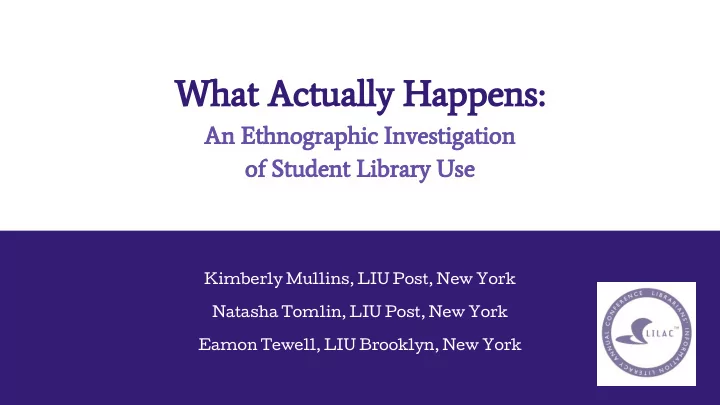

What Actually Happens: An Ethnographic Investigation of Student Library Use Kimberly Mullins, LIU Post, New York Natasha Tomlin, LIU Post, New York Eamon Tewell, LIU Brooklyn, New York
Research Team LIST OF PARTICIPANTS - BROOKLYN Katherine Boss Valeda Dent ETHNOGRAPHIC CODING TEAM MEMBERS Charles Guarria Valeda Dent Rachel King Edward Keane Paula Patiño Kimberly Mullins Susan Thomas Paula Patiño Ingrid Wang Bhavya Teja Kolla Gloria Willson Eamon Tewell Natasha Tomlin LIST OF PARTICIPANTS - POST Mary Kate Boyd-Byrnes Kathleen Burlingame Thomas Dillman Mellissa Hinton Kimberly Mullins Eduardo Rivera Derek Stadler Natalia Tomlin
Background
Our University
Our Study’s Timeline Summer 2012 IRB approval received Fall 2012 Survey distributed Spring 2013 Observations conducted Spring 2013 Interviews conducted Spring 2014 Coding process started Spring 2016 Coding process completed
Ethnographic Research ● The study of a culture to improve one’s understanding of it ● Investigates few cases in thorough detail ● Qualitative methods, rooted in anthropology: participant observation, in-depth interviews, etc. ● Time intensive!
Why? ● Examine our local culture of student research habits ● Provide need-based services ● Make ethnography a consistent and ongoing practice
Previous Major Studies ● University of Rochester “Studying Students” Project http://www.alastore.ala.org/detail.aspx?ID=2322 ● Rutgers Ethnographic Research Project http://www.libraries.rutgers.edu/rul/staff/groups/ethnography/reports. shtml ● University of Illinois ERIAL Project http://www.erialproject.org ● CUNY Undergraduate Scholarly Habits Ethnography Project https://ushep.commons.gc.cuny.edu
Our Study: Mixed Methods Research SURVEYS OBSERVATIONS INTERVIEWS
Data Collection
Survey Overview ● Fifty-one questions on technology integration, library use, and research and study habits ● Administered Fall 2012 ● 1100+ responses ● Used survey data to create interview questions
Sample Survey Questions “Have you had any library instruction while at Long island University?” “During the last academic year, how often was the Libraries' website a basic part of your research process?” “Which of these resources do you use most often?” “Would you use text messaging to get an answer to a reference or research question from the LIU Libraries?”
LIU Post Survey Team
Survey Kick-Off Party
Survey Demographics
Observation Overview ● 32 hours of unobtrusive observations in the Post and Brooklyn Libraries ● Recorded field notes ● Recorded interpretations ● Used observational data to create interview questions
Observation Recording Sheet
Interview Overview ● Recruited interviewee during the survey stage ● Conducted 30 one-hour semi-structured interviews ● Included “show me” questions ● Videotaped and professionally transcribed audio
Interview Questions “When you get an assignment for a class, what is the very first thing you do?” “Do you seek help from library personnel?” “When you study in the library, do you prefer to be around other students, or have more of your own personal space?”
Interview Demographics
Data Analysis
Survey Analysis 1. Library staff and graduate student entered data into SPSS 2. Quantitatively analysed closed-ended questions using proprietary survey software 3. Performed content analysis for open-ended questions
Survey Analysis 4. Graphically depicted major themes to identify “areas of focus” 5. Themes further analyzed
Survey Analysis
Observation and Interview Codebook 1. Started with observations and sample interview word counts 2. Added codes identified through coding process (6 iterations) 3. Resulted in 459 codes at question, unit, and thematic levels
Observation Coding 1. Combined into one document and analyzed for frequency counts 2. Read field notes and coded the text 3. Library staff and graduate student entered data into SPSS 4. Statistical analysis performed
Interview Coding 1. Transcripts coded individually, by pairs and as a team (4 coders) 2. Paired teams and entire team reconciled coding to ensure inter-coder reliability 3. Library staff and graduate student entered data into SPSS 4. Statistical analysis performed
Findings
Survey Findings ● 75% of students received some type of instruction on how to utilize the Library and its resources ● 60% of students use the Libraries’ website between 1 and 4 times per week ● Students use Google and the Libraries’ databases equally to complete their work ● Majority of students were not taking advantage of University iPad program
Observation Findings ● Coming and going; leaving personal items ● “Cocooning” ● Multitasking supported by technology ● Seated in groups but working individually ● Headphones for music or to signal need for uninterruption
Interview Findings ● Students go to peers and instructors first for research questions; embarrassed to approach librarians ● Creation of study materials using flash card apps or compiling materials in iBooks app ● Need for more comfortable spaces and extended library hours
Interview Findings Library & Non-Library Resources
Interview Findings Use of Library Resources
Interview Findings Use of Library Space
Triangulation
Library Instruction INTERVIEW SURVEY
Print vs. eBooks INTERVIEW SURVEY
Librarian Contact INTERVIEW SURVEY
Non-Library Resources INTERVIEW SURVEY
Important “Triangulation” Tidbits ● Librarians are the third point of reference ● Students DO evaluate sources ● Students prefer shelf browsing ● Signage is important
Changes Made
Instruction ● At one campus, basic library instruction and an information literacy exam were integrated within the first semester curriculum ● At another campus, librarians performed syllabus analysis for various Departments to identify library instruction opportunities ● Librarians became involved in Learning Communities to communicate directly with students early in their academic careers
Reference Services ● Extended hours ● Website redesign ● Skype by appointment
Space Modifications ● Both libraries underwent renovations that include additional group study areas and natural light ● A “lounge environment” and group tables were added ● “Genius Bar” workspace was implemented
Post Library Renovations
Brooklyn Library Renovations (Before)
Brooklyn Library Renovations (After)
Questions? Kimberly.Mullins@liu.edu Natalia.Tomlin@liu.edu Eamon.Tewell@liu.edu @EamonTewell
Recommend
More recommend